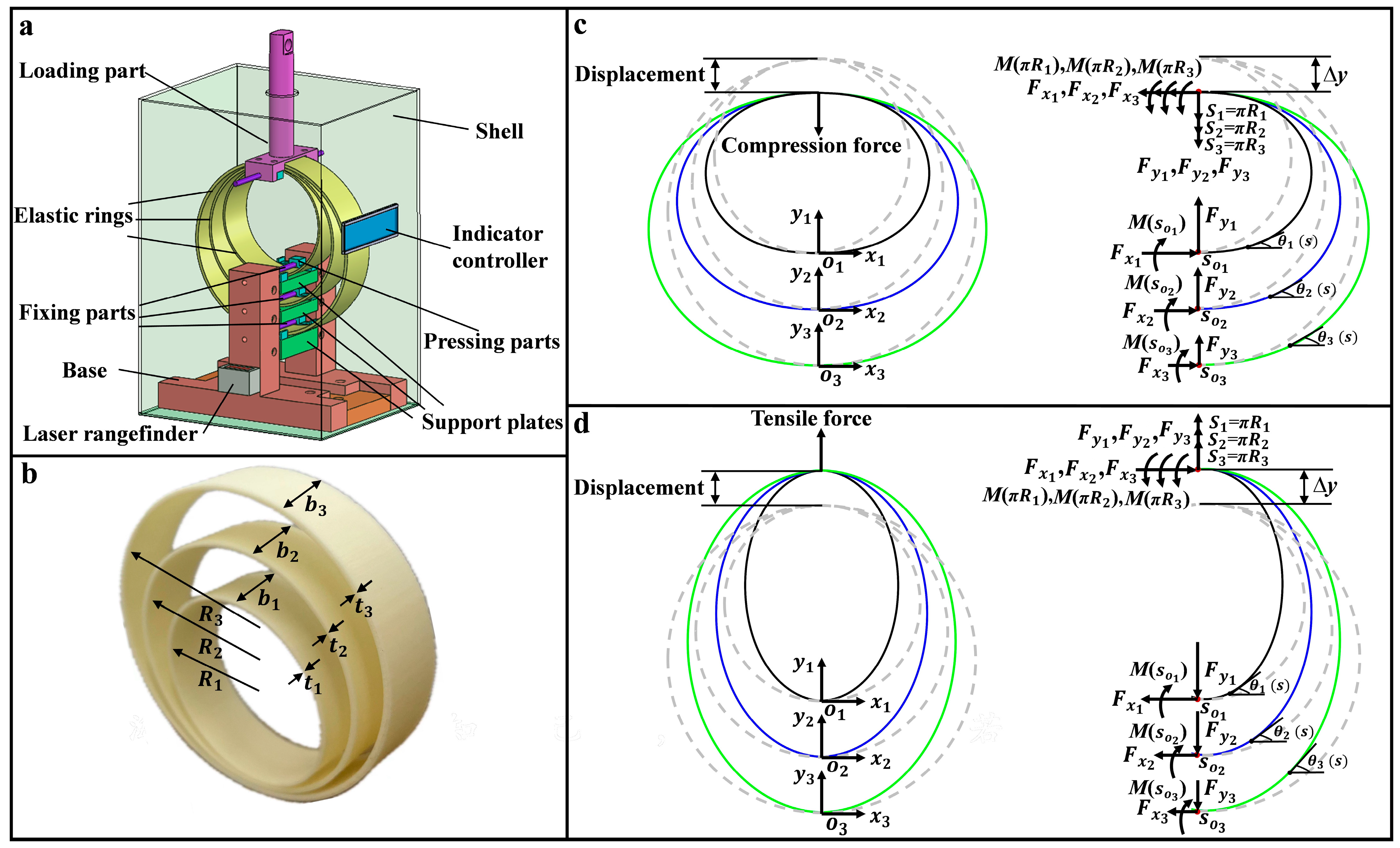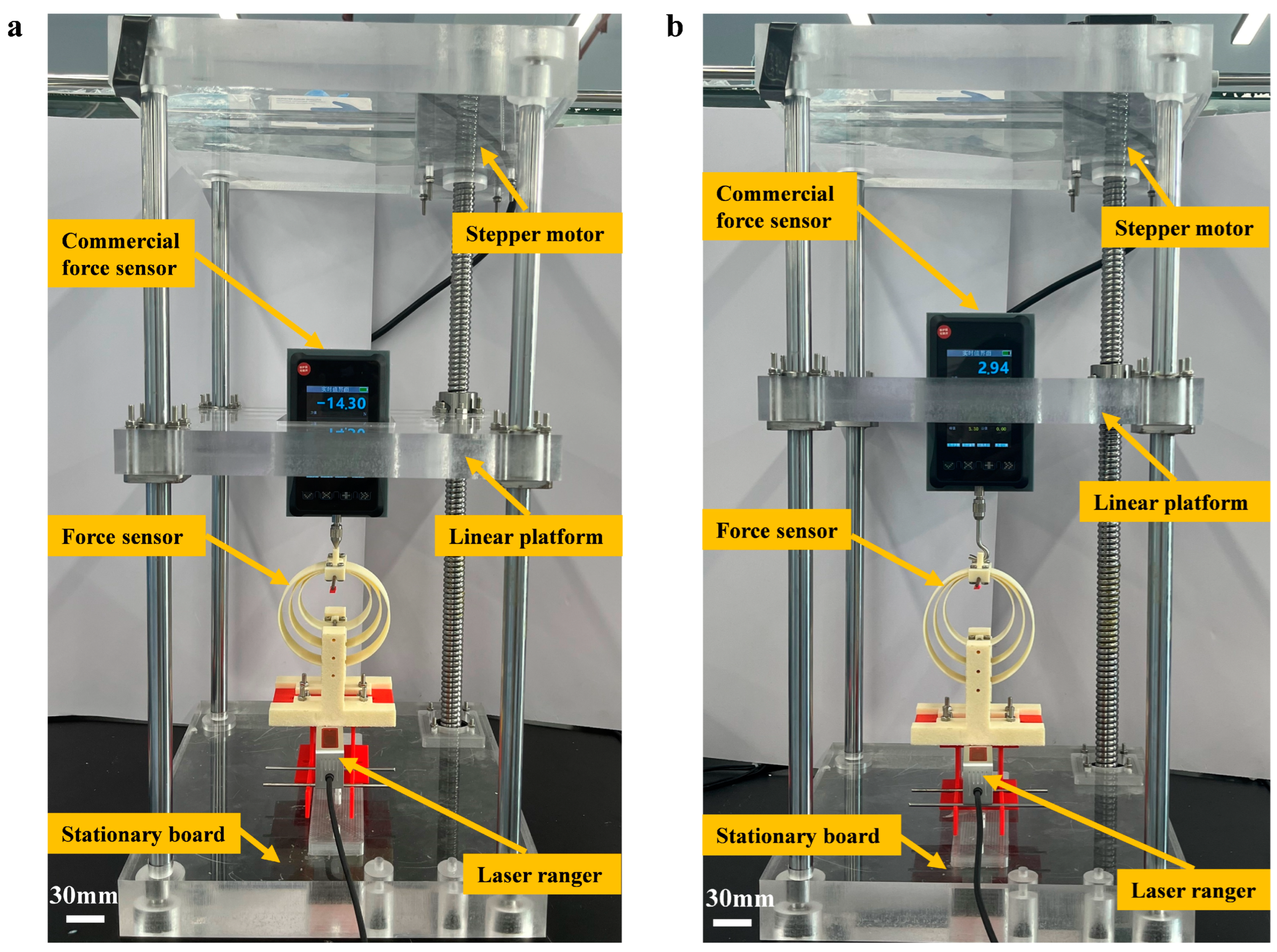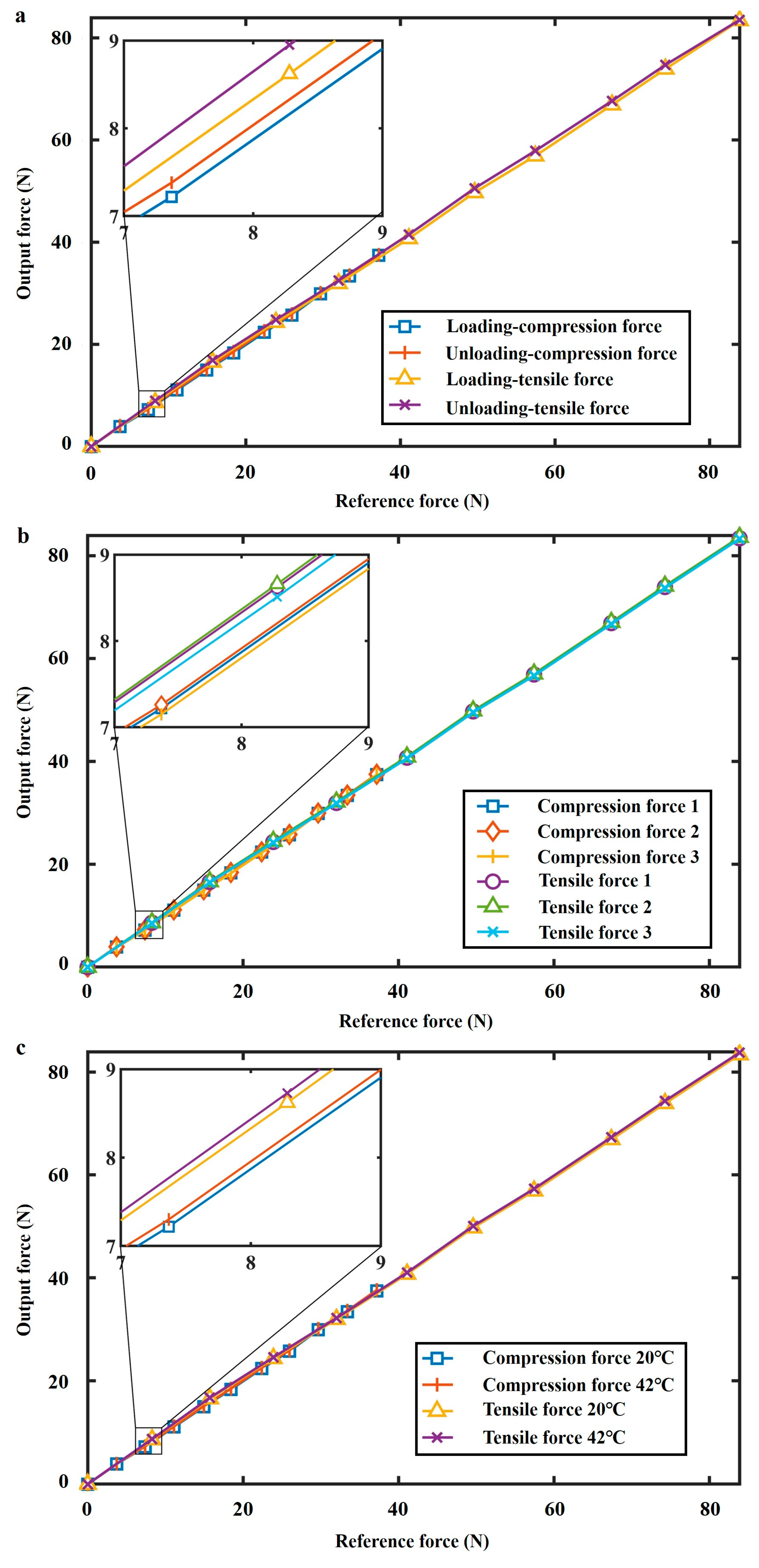Design and Validation of Single-Axis 3D-Printed Force Sensor Based on Three Nested Flexible Rings
Abstract
:1. Introduction
2. Structural Design and Sensing Scheme
2.1. Structural Design
2.2. Analytical Model
3. FEM Simulation
4. Experimental Setup and Testing Results
4.1. Experimental Setup
4.2. Force-Displacement Characteristic Experiment
4.3. Performance Test
5. Discussion
6. Conclusions
Supplementary Materials
Author Contributions
Funding
Institutional Review Board Statement
Informed Consent Statement
Data Availability Statement
Acknowledgments
Conflicts of Interest
References
- Yang, P.F.; Chen, Y.; Chen, Y.L.; Dang, F. Gyro-Free inertial measurement unit with unfettered accelerometer array distribution and for the object with position change in center of gravity. IEEE Sens. J. 2021, 21, 9423–9435. [Google Scholar] [CrossRef]
- He, Y.; Wu, J.X.; Lin, M.X.; Xiao, S.; Liu, H.; Zhou, P. Ionic flexible force sensors and their potential applications. J. Mater. Chem. C 2021, 9, 16378–16390. [Google Scholar] [CrossRef]
- Chuang, C.H.; Lee, D.H.; Chang, W.J.; Weng, W.C.; Shaikh, M.O.; Huang, C.L. Real-Time monitoring via patch-type piezoelectric force sensors for internet of things based logistic. IEEE Sens. J. 2017, 17, 2498–2506. [Google Scholar] [CrossRef]
- Li, B.; Gil, B.; Power, M.; Gao, A.Z.; Treratanakulchai, S.; Anastasova, S.; Yang, G.Z. Carbon-Nanotube-Coated 3d microspring force sensor for medical applications. ACS Appl. Mater. Interfaces 2019, 11, 35577–35586. [Google Scholar] [CrossRef]
- Yang, P.F.; Xin, S.W.; Dang, F. A single-axis force sensor based on a 3d-printed elastic ring. Measurement 2024, 236, 115140. [Google Scholar] [CrossRef]
- Fu, L.Y.; Song, A.G. Model-Based load characteristics analysis of the multi-dimensional force sensor. IEEE Access 2020, 8, 116431–116440. [Google Scholar] [CrossRef]
- Diethold, C.; Kühnel, M.; Hilbrunner, F.; Froehlich, T.; Manske, E. Determination of force to displacement curves using a nanopositioning system based on electromagnetic force compensated balances. Measurement 2014, 21, 343–348. [Google Scholar] [CrossRef]
- Li, H.F.; Liu, C.S. Design and experimental validation of novel force sensor. IEEE Sens. J. 2015, 15, 4402–4408. [Google Scholar] [CrossRef]
- Zhu, Y.L.; Chen, X.; Chu, K.M.; Wang, X.; Hu, Z.Q.; Su, H.J. Carbon back/PDMS based flexible capacitive tactile sensor for multi-directional force sensing. Sensors 2022, 22, 628. [Google Scholar] [CrossRef]
- Hidalgo, J.A.; Oballe-Peinado, O.; Castellanos-Ramos, J.; Tejero-Calado, J.C.; Vidal-Verdu, F. Wide range calibration method for direct interface circuits and application to resistive force sensors. IEEE Sens. J. 2021, 21, 22956–22966. [Google Scholar] [CrossRef]
- Gavrilenkov, S.I.; Gavriushin, S.S.; Godzikovsky, V.A. Multicriteria approach to design of strain gauge force transducers. J. Phys. Conf. Ser. 2019, 1379, 012010. [Google Scholar] [CrossRef]
- Tamura, R.; Horikoshi, T.; Sakaino, S.; Tsuji, T. High dynamic range 6-axis force sensor employing a semiconductor-metallic foil strain gauge combination. IEEE Robot. Autom. Lett. 2021, 6, 6243–6249. [Google Scholar] [CrossRef]
- Sun, Y.J.; Liu, Y.W.; Zou, T.; Jin, M.H.; Liu, H. Development and evaluation of a sensor glove for hand function assessment and preliminary attempts at assessing hand coordination. Measurement 2015, 65, 135–148. [Google Scholar] [CrossRef]
- Mirfakhrai, T.; Oh, J.; Kozlov, M.E.; Fang, S.L.; Zhang, M.; Baughman, R.H.; Madden, D.W. Mechanoelectrical force sensors using twisted yarns of carbon nanotubes. IEEE/ASME Trans. Mechatron. 2011, 16, 90–97. [Google Scholar] [CrossRef]
- Gao, S.; Guo, R.; Xu, L.J. A touch orientation classification-based force–voltage responsivity stabilization method for piezoelectric force sensing in interactive displays. IEEE Sens. J. 2020, 20, 8147–8154. [Google Scholar] [CrossRef]
- Meng, H.L.; Zhu, W.H.; Zhou, L.X.; Qian, X.; Bao, G.J. A 3D force sensor based on combination of magnetic and piezoresistive transduction. IEEE Sens. J. 2022, 22, 3595–3604. [Google Scholar] [CrossRef]
- Adelsberg, N.; Weber, Y.; Yoffe, A.; Shilo, D. Wireless thin layer force sensor based on a magnetostrictive composite material. Smart Mater. Struct. 2017, 26, 065013. [Google Scholar] [CrossRef]
- Noh, Y.; Liu, H.B.; Sareh, S.; Chathuranga, D.S.; Wurdemann, H.; Rhode, K.; Althoefer, K. Image-Based optical miniaturized three-axis force sensor for cardiac catheterization. IEEE Sens. J. 2016, 16, 7924–7932. [Google Scholar] [CrossRef]
- Zhang, Z.J.; Chen, Y.P.; Zhang, D.L. Development and application of a tandem force sensor. Sensors 2020, 20, 6042. [Google Scholar] [CrossRef]
- Saxena, R.; Ghoshal, S.K.; Kumar, H. Design investigations of axis-symmetrical force transducers. MAPAN J. Metrol. Soc. India 2019, 34, 511–519. [Google Scholar] [CrossRef]
- Majcherek, S.; Aman, A.; Fochtmann, J. A MEMS sensor for microscale force measurements. J. Micromech. Microeng. 2016, 26, 025013. [Google Scholar] [CrossRef]
- Kebede, G.A.; Ahmad, A.R.; Lee, S.C.; Lin, C.Y. Decoupled six-axis force-moment sensor with a novel strain gauge arrangement and error reduction techniques. Sensors 2019, 19, 3012. [Google Scholar] [CrossRef] [PubMed]
- Lin, C.Y.; Ahmad, A.R.; Kebede, G.A. Novel mechanically fully decoupled six-axis force-moment sensor. Sensors 2020, 20, 395. [Google Scholar] [CrossRef]
- Kang, M.K.; Lee, S.; Kim, J.H. Shape optimization of a mechanically decoupled six-axis force/torque sensor. Sens. Actuators A Phys. 2014, 209, 41–51. [Google Scholar] [CrossRef]
- Kusumi, K.; Nakamoto, H.; Kobayashi, F.; Nagahata, Y. Development of magnetic food texture sensor with spring and sliding mechanism. In Proceedings of the IEEE SENSORS Conference, Rotterdam, The Netherlands, 25–28 October 2020. [Google Scholar]
- AI-Dahiree, O.S.; Tokhi, M.O.; Hadi, N.H.; Hmoad, N.R.; Yap, H.J.; Albaadani, E.A. Design and shape optimization of strain gauge load cell for axial force measurement for test benches. Sensors 2022, 22, 7508. [Google Scholar] [CrossRef]
- Blakeborough, A.; Clément, D.; Williams, M.S.; Woodward, N. Novel load cell for measuring axial force, shear force, and bending movement in large-scale structural experiments. Exp. Mech. 2002, 42, 115–122. [Google Scholar] [CrossRef]
- Nie, Q.D.; Sup, F.C. A soft four degree-of-freedom load cell based on the hall effect. IEEE Sens. J. 2017, 21, 7355–7363. [Google Scholar] [CrossRef]
- Kim, U.; Lee, D.H.; Kim, Y.B.; Seok, D.Y.; Choi, H.R. A novel six-axis force/torque sensor for robotic applications. IEEE/ASME Trans. Mechatron. 2017, 22, 1381–1391. [Google Scholar] [CrossRef]
- Nie, Y.J.; Wu, L.C.; Ke, J.D.; Lu, T.F. Planar six-axis force and torque sensors. IEEE Sens. J. 2021, 21, 26631–26641. [Google Scholar]
- Asghar, A.; Fallah, A.S.; Seneviratne, L.D.; Dasgupta, P.; Althoefer, K. Novel force sensing approach employing prismatic-tip optical fiber inside an orthoplanar spring structure. IEEE/ASME Trans. Mechatron. 2014, 19, 121–130. [Google Scholar]
- Qu, J.T.; Wu, Q.Y.; Clancy, T.; Fan, Q.G.; Wang, X.; Liu, X.Y. 3D-Printed strain-gauge micro force sensors. IEEE Sens. J. 2020, 20, 6971–6978. [Google Scholar] [CrossRef]
- Tang, Z.X.; Wang, S.X.; Shi, C.Y. Development of a hybrid force-displacement sensor based on fiber bragg grating for radial artery pulse waveform measurement. IEEE Sens. J. 2021, 21, 20045–20054. [Google Scholar] [CrossRef]
- Liu, M.J.; Zhang, Q.; Shao, Y.W.; Liu, C.Q.; Zhao, Y.L. Research of a novel 3D printed strain gauge type force sensor. Micromachines 2019, 10, 20. [Google Scholar] [CrossRef] [PubMed]
- Pieniazek, J.; Ciecinski, P. Temperature and nonlinearity compensation of pressure sensor with common sensors response. IEEE Trans. Instrum. Meas. 2020, 69, 1284–1293. [Google Scholar] [CrossRef]
- Yang, P.F.; Dang, F.; Liao, X.B.; Chen, X. Buckling morphology of an elastic ring confined in an annular channel. Soft Matter 2019, 15, 5443–5448. [Google Scholar] [CrossRef]
- Yang, P.F.; Huang, R.X.; Dang, F.; Shan, B.X.; Wang, D.W.; Liu, H.; Li, Y.; Liao, X.B. Motorizing the buckled blister for rotary actuation. Exploration 2024, 20230055. [Google Scholar] [CrossRef]
- Yang, P.F.; Wang, D.W.; Liu, H.; Huang, R.X.; Li, X.F.; Xin, S.W.; Huang, F.; Dang, F. Spontaneous buckling morphology transition of an elastic ring confined in an annular region constraint. Eur. J. Mech.—A/Solids 2023, 100, 105026. [Google Scholar] [CrossRef]







| Force | Hysteresis Error | Straightness Error | Repeatability Error | Temperature Error | Cyclic Error | Creep Error |
|---|---|---|---|---|---|---|
| Compression Force | 0.71% | 0.69% | 0.42% | 0.48% | 0.62% | 0.13% |
| Tensile Force | 1.18% | 0.77% | 0.46% | 0.56% | 0.73% | 0.19% |
| FS | Error | Range | Dimension | Applications | Mass | Cost |
|---|---|---|---|---|---|---|
| Tandem FS [19] | 1.54% | 0–819 N | Length 7 cm Diameter 3.2 cm | Robotics and perceptual information | \ | \ |
| Axis-Symmetrical Force Transducers [20] | 3.0% | 0–50 kN | Length 19 cm Breadth 5 cm Height 19 cm | Automation industries and verification of material testing machines | \ | \ |
| MEMS FS [21] | 1.0% | 0.5–5 N | Length 1.1 cm Breadth 0.12 cm Thickness 0.06 cm | Automotive industry | \ | \ |
| FS with novel strain gauge [22] | 1.78% | 0–800 N | Length 1.75 cm Breadth 0.8 cm Height 0.8 cm | Intelligent automation of robot | \ | \ |
| Novel six-axis FS [23] | 2.0% | 0–800 N | Length 1.75 cm Breadth 0.8 cm Height 0.8 cm | Robotics | \ | \ |
| Mechanical decoupling FS [24] | 5.2% | 0–800 N | Length 3.7 cm Diameter 9.2 cm | Biomechanics and sports medicine | \ | \ |
| Weight sensing device [27] | 5.0% | 0–500 kN | Length 40 cm Breadth 12.5 cm Height 5 cm | Detection of heavy objects | \ | \ |
| Flexible FS based on the hall effect [28] | 6.9% | 0–40 N | Diameter 6 cm Height 1.1 cm | Tactile and healthcare applications | \ | \ |
| Novel sensor for robot applications [29] | 1.18% | 0–50 N | Diameter 2.5 cm Height 1.9 cm | Robot applications | \ | \ |
| Planar force and torque sensors [30] | 0.29% | 0–0.1 kN | Diameter 7.5 cm Height 1.2 cm | Robotic systems | \ | \ |
| 3D-printed FS utilizing elastic elements arranged orthogonally [31] | 2.18% | 0–2.8 N | Diameter 7 cm Height 0.4 cm | Automated manipulation and advanced manufacturing | \ | \ |
| 3D-printed micro-FS [32] | 1.14% | 0–0.12 N | Length 3.5 cm Breadth 1 cm Height 0.3 cm | Microscale integration, healthcare implementations and fine-tuning of microdevices | \ | \ |
| 3D-printed FS utilizing optical fiber grating [33] | 0.98% | 0.9–2.7 N | Length 5.7 cm Diameter 3 cm | Analysis of pulse patterns | \ | \ |
| Forsentek-F3F (Forsentek Enterprise) | 0.3% | 0–2 kN | Length 12 cm Breadth 12 cm Height 3 cm | Automated systems, force simulation platform, and industrial testing | 3.2 kg | $1236 |
| DAYSENSOR DY920-B (Dayang Sensing Enterprise) | 0.1% | 0–100 N | Length 13.2 cm Breadth 7.6 cm Height 2 cm | Industrial production and automation | 0.5 kg | $123 |
| Burster 8524-series (Burster Enterprise) | 0.1% | 0–2 kN | Height 1.6 cm Diameter 5.45 cm | Machinery industry and batch weighing apparatus | 0.57 kg | $751 |
| This work | 0.77% | 0–83 N | Length 9.8 cm Breadth 7 cm Height 8.8 cm | Robotics, automotive industry, and iatrical equipment | 0.3 kg | $28 |
Disclaimer/Publisher’s Note: The statements, opinions and data contained in all publications are solely those of the individual author(s) and contributor(s) and not of MDPI and/or the editor(s). MDPI and/or the editor(s) disclaim responsibility for any injury to people or property resulting from any ideas, methods, instructions or products referred to in the content. |
© 2024 by the authors. Licensee MDPI, Basel, Switzerland. This article is an open access article distributed under the terms and conditions of the Creative Commons Attribution (CC BY) license (https://creativecommons.org/licenses/by/4.0/).
Share and Cite
Yang, P.; Xin, S.; Mao, Y.; Dang, F.; Huang, F. Design and Validation of Single-Axis 3D-Printed Force Sensor Based on Three Nested Flexible Rings. Sensors 2024, 24, 5441. https://doi.org/10.3390/s24165441
Yang P, Xin S, Mao Y, Dang F, Huang F. Design and Validation of Single-Axis 3D-Printed Force Sensor Based on Three Nested Flexible Rings. Sensors. 2024; 24(16):5441. https://doi.org/10.3390/s24165441
Chicago/Turabian StyleYang, Pengfei, Shiwei Xin, Yuqing Mao, Fei Dang, and Feng Huang. 2024. "Design and Validation of Single-Axis 3D-Printed Force Sensor Based on Three Nested Flexible Rings" Sensors 24, no. 16: 5441. https://doi.org/10.3390/s24165441





